OSEI New Co-located Space

Designing for Equity & Inclusion
Welcome to the Office of Student Equity and Inclusion (OSEI), home to five flagship centers and programs: the Center for Multicultural Equity & Access (CMEA), the Community Scholars Program (CSP), the LGBTQ Resource Center, the Women’s Center, and the Disability Cultural Center. This space was meticulously designed through intentional collaboration across all OSEI units, with engagement from our communities. Over the past three years, our team has worked closely with the Cannon Group, Georgetown Capital Projects, as well as contractors, architects, graphic designers, interior designers, students, and campus affiliates to ensure an intersectional approach in co-creating this space with a collective purpose and dream together about what a “community in diversity” could look like at Georgetown.
The result is a product of innovation, commitment to values, and imagining a Georgetown where all are celebrated. Our aim is to honor the individual identities of our students while fostering a sense of belonging and inclusion.The space was designed to offer improved programming areas for the units, facilitate cross collaboration and learning, provide better access to resources, offer opportunities for art and cultural exchange, and include entertainment and quiet rooms. It serves as a hub where students can study, engage in group settings, work, socialize, and express their authentic selves. Our goal is to cultivate compassion and cura personalis while providing a safe space where all intersecting identities are welcomed.
Space Features & Design
The space encompasses approximately 10,140 square feet and features 19 offices, 4 conference rooms, a multipurpose room, and a unique sensory room—the first of its kind at a university in the District. It includes 31 student work stations, 2 lounge areas, and gender neutral, accessible bathrooms designed for enhanced privacy and access. Other amenities include a communal kitchen, print and copy stations, and 2 storage rooms.

The design aesthetic prioritizes a neutral theme, evident in the earth tones, accessible flooring and ceiling materials, finishings, color scheme, and furniture. We opted for a neutral palette initially to ensure longevity in the space’s aesthetic and to allow individual offices to personalize the space as our student body evolves. Fun fact, the floors were lowered by 17 inches to increase the space’s height and brightness.

When addressing accessibility, OSEI wanted the space to be functionally accessible for our community members. We worked with our community members on campus to ensure that various features, such as coat hooks, microwaves, door handles, carpet, and restrooms, were chosen for accessibility. Our sensory room features a relaxed environment with interactive light technology, bean bags, weighted stuffed animals, custom sensory art, and stim tools and toys for students to use. Additionally, assistive listening technology was integrated into the space to provide real-time audio streaming to any mobile device using an app. Colors were chosen to contrast with a variety of skin tones for ASL interpretation, and lighting and ventilation was selected to enhance accessibility.

As you explore the space, you’ll notice tactile signage and braille for our blind and low vision community members. The street signs atop each area were carefully chosen by the OSEI team, featuring names like Dignity Drive, Solitary Street, Access Alley, Social Justice Junction, Belonging Blvd, and Cura Personalis Drive. Two of each street sign are installed, one at each end of the hallway, adding another layer of diversity and inclusion themes to the space.
To learn more about the space check out the Georgetown Unveils Community Space, New Home for Student Equity and Inclusion Office article.
Space Graphics: Learn More

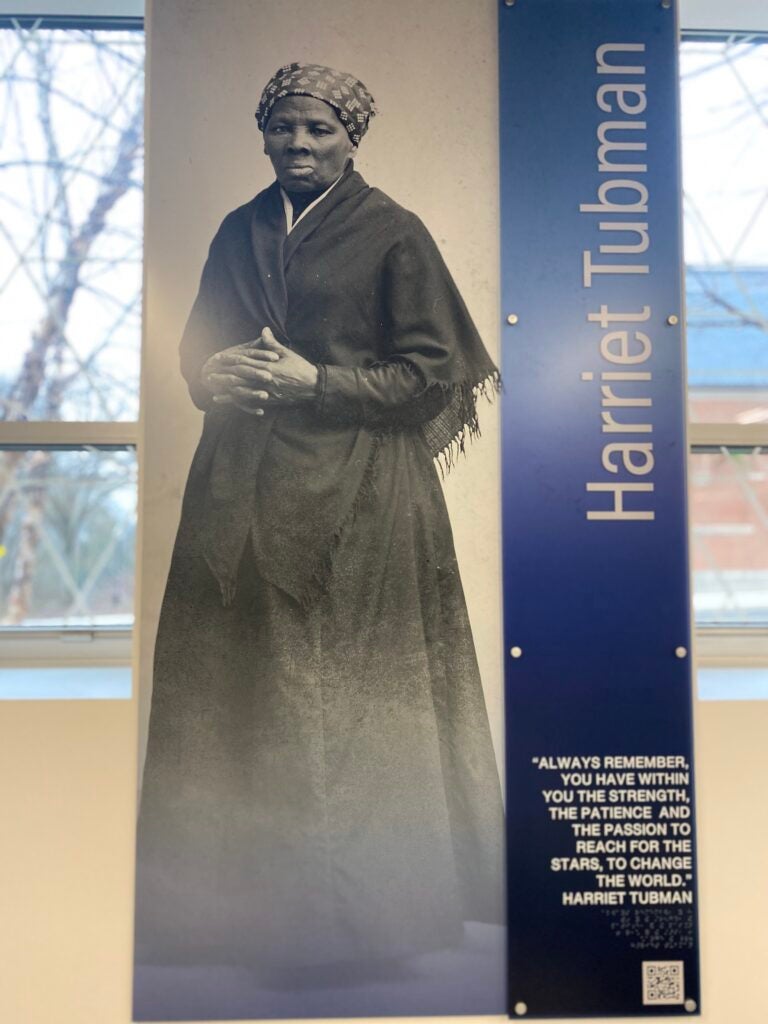
About Harriet Tubman
Born into slavery around 1820 in Maryland, Harriet Tubman became one of the most prominent figures in American history. She escaped slavery in 1849 and subsequently dedicated her life to helping others attain their freedom through the Underground Railroad, a network of safe houses and secret routes. Tubman’s daring efforts resulted in the rescue of numerous enslaved individuals, earning her the nickname “Moses.”
Tubman’s commitment to the abolitionist cause extended beyond her work with the Underground Railroad. During the Civil War, she served as a nurse, cook, and spy for Union forces, further contributing to the fight against slavery. Tubman’s leadership, courage, and resilience made her a symbol of the struggle for freedom and equality.
Later in life, Tubman continued her advocacy for civil rights and women’s suffrage. She lived to see the end of slavery and played a crucial role in shaping the course of American history. Harriet Tubman’s legacy endures as a beacon of inspiration, a testament to the power of determination and the pursuit of justice in the face of adversity.
Resources to Learn More
Bradford, S. H. (2022). Harriet Tubman, the Moses of Her People. DigiCat.
Humez, J. M. (2006). Harriet Tubman: The life and the life stories. Univ of Wisconsin Press.
Documentary on Harriet Tubman: https://www.pbs.org/show/harriet-tubman-visions-freedom/
Image Description
A black and white photo of Harriet Tubman wearing a dress. To the right of the image, the text reads: “Harriet Tubman. “Always remember, you have within you the strength, the patience, and the passion to reach for the stars, to change the world. -Harriet Tubman.”
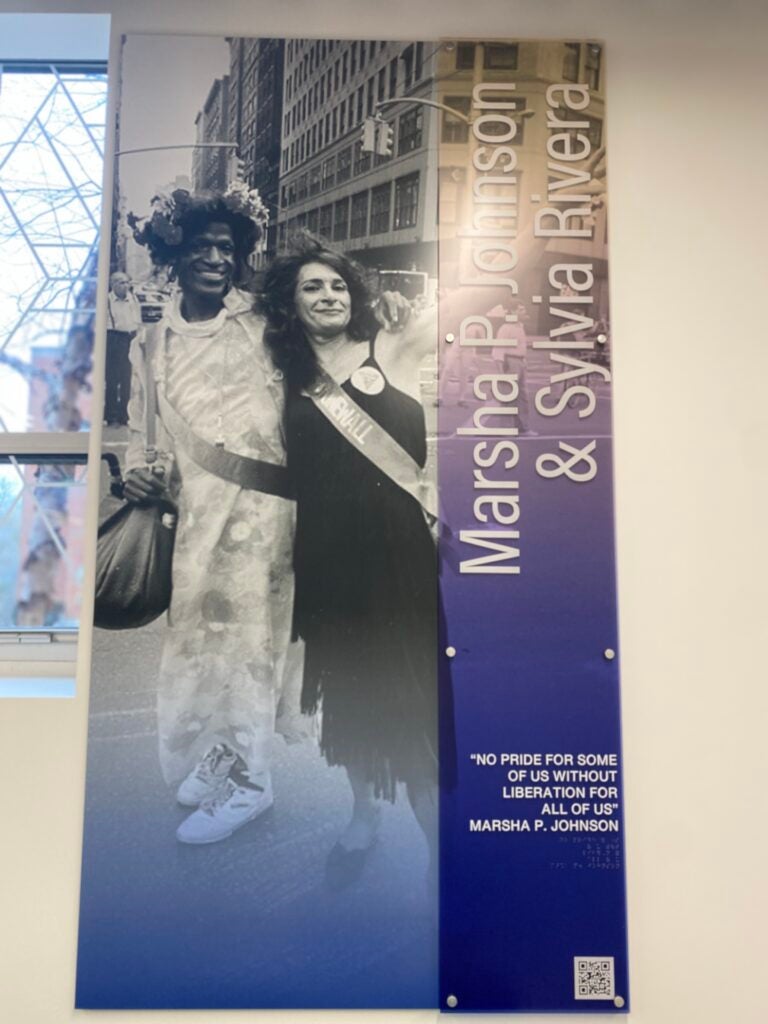
About Marsha P. Johnson and Sylvia Rivera
Legacy of LGBTQ+ Pioneers- Marsha P. Johnson and Sylvia Rivera were pioneering figures in the LGBTQ+ rights movement, particularly known for their activism within the transgender and queer communities. Both were instrumental in the early days of the Gay Liberation Movement and played pivotal roles in the Stonewall Uprising of 1969, a key moment in the fight for LGBTQ+ rights.
Marsha P. Johnson, a Black transgender woman, co-founded the Gay Liberation Front and later the Street Transvestite Action Revolutionaries (STAR) with Sylvia Rivera. She was a tireless advocate for the rights of transgender and homeless individuals, working towards inclusivity and equality within the broader LGBTQ+ movement.
Sylvia Rivera, also a transgender activist of Puerto Rican and Venezuelan descent, was a co-founder of STAR alongside Johnson. She dedicated her life to advocating for the rights of transgender and low-income individuals, emphasizing the importance of intersectionality within the LGBTQ+ movement.
Both Johnson and Rivera faced significant challenges, including homelessness and discrimination, but their resilience and activism laid the foundation for future advancements in LGBTQ+ rights. Their legacy extends beyond the Stonewall Uprising, as they continued to fight for marginalized communities until their deaths.
Resources to Learn More
To learn more about Marsha P. Johnson and Sylvia Rivera, you can explore documentaries like “The Death and Life of Marsha P. Johnson” and Sylvia Rivera’s detailed biography.
Additionally, books such as “Trans Bodies, Trans Selves” provide in-depth insights into their contributions to the transgender and queer rights movements. The Marsha P. Johnson Institute and the Sylvia Rivera Law Project also carry on their legacies by advocating for transgender and non-binary individuals today.
Image Description
Marsha P. Johnson and Sylvia Rivera pose together with spring-colored flowers in their hair with the rainbows outlining their bodies while the rest of the photo is black and white. The quote reads: “No pride for some of us without liberation for all of us – Marsha P. Johnson”. Braille and a QR code are below.
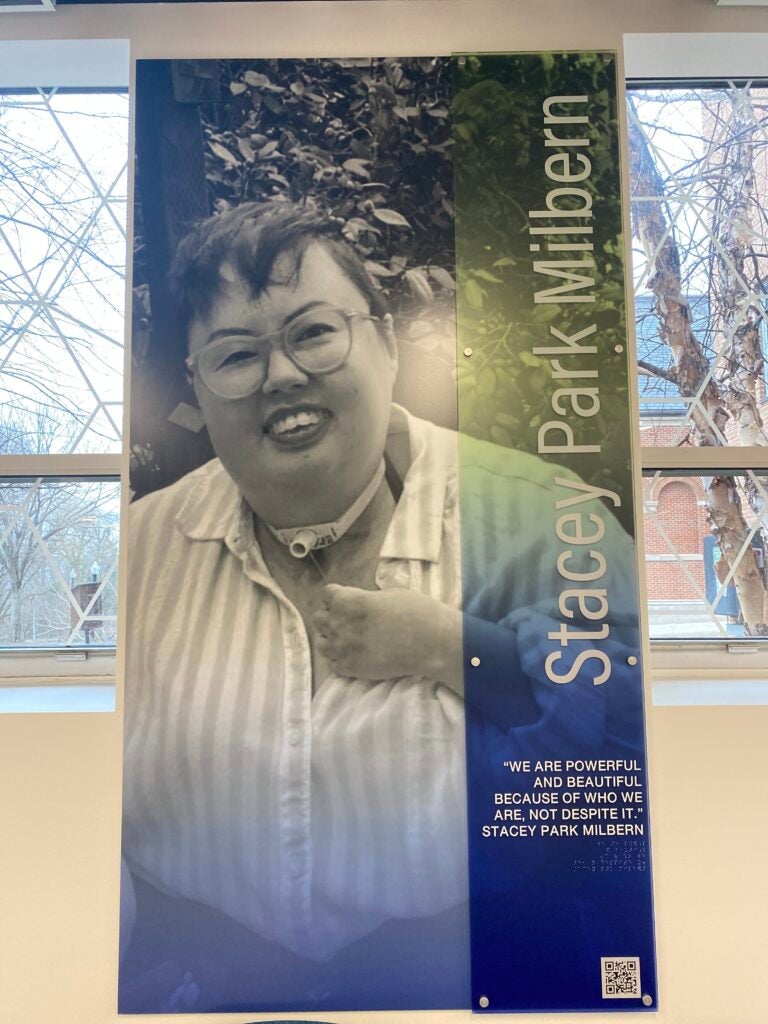
About Stacey Park Milbern
Stacey Park Milbern (1987-2020) was a Korean-American, queer, disability justice activist. Together with queer, disabled, Black, Indigenous, and people of color in San Francisco, Milbern created Disability Justice Culture Club (DJCC), which mobilized to provide mutual aid to the community and provide a home for low-income disabled BIPOC. In 2014, President Barack Obama appointed Milbern to the President’s Committee for People with Intellectual Disabilities.
When Pacific Gas & Electric shut off power to thousands of households during the California wildfires in 2019, Milbern and the DJCC created the “Power To Live” campaign to distribute generators to people who needed electricity for ventilators and other mobility aids. The campaign increased awareness about the impacts of voluntary power shut offs on disabled people through the mutual assistance organizing of Milbern and the DJCC. Given this legacy as a disability justice advocate, Milbern was selected to be featured on the 2025 American Women Quarters Program.
Milbern was an advocate for centering joy, radical love, and community care. Leah Lakshmi Piepzna-Samarasinha, Alice Wong, and Radical Monarchs created a syllabus with a small collection of interviews, blog posts, and videos honoring what Milbern taught us about organizing, love, and disability justice.
Resources to Learn More
Disability Visibility podcast (2017): episode 6: Labor, Care Work, and Disabled Queer Femmes.
Stacey Park Milbern, “On the Ancestral Plane: Crip Hand Me Downs and the Legacy of Our Movements.” 2019.
#StaceyTaughtUs. 2020.
Image Description
A black and white photo of Stacey Park Milbern, a mixed race Korean and white queer person, smiling while wearing a striped shirt and glasses. Milbern’s trach and wheelchair can be seen. To the right of the image, the text reads: “Stacey Park Milbern. We are powerful and beautiful because of who we are, not despite it. Stacey Park Milbern.”
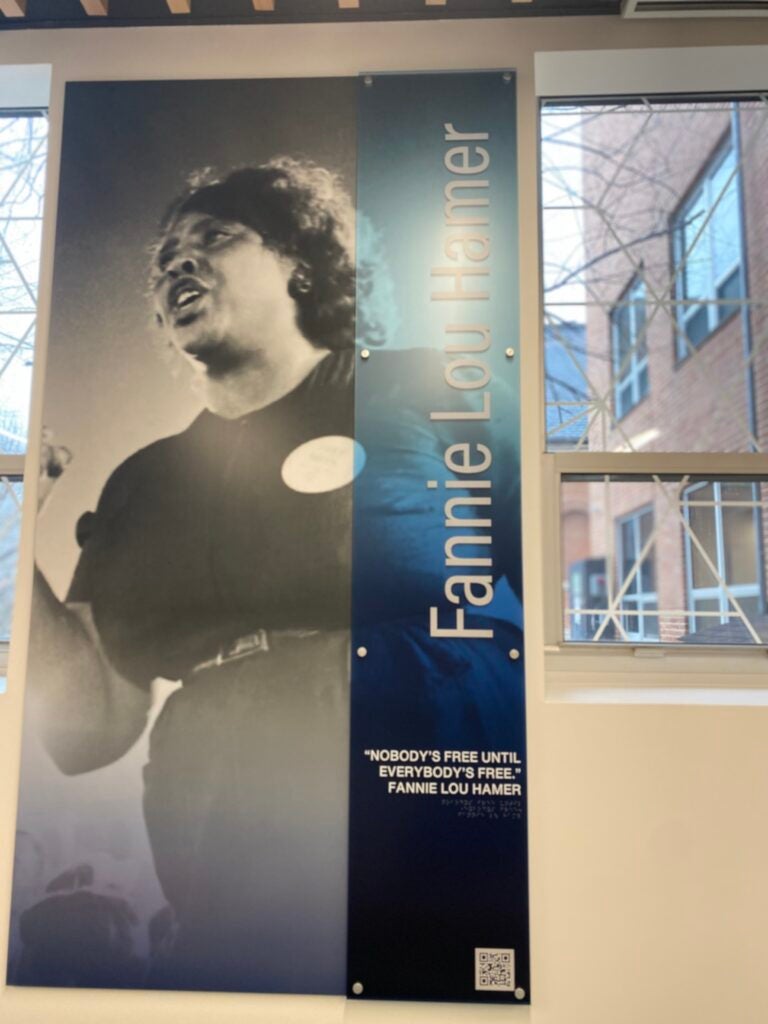
About Fannie Lou Hamer
Fannie Lou Hamer (1917-1977) was a fearless African American civil rights activist, known for her unwavering commitment to the fight against racial injustice and her tireless efforts to secure voting rights for African Americans in the United States. Born in Mississippi, Hamer became a prominent figure in the Civil Rights Movement during the 1960s.
Hamer’s activism gained national attention when she and other members of the Student Nonviolent Coordinating Committee (SNCC) attempted to register to vote in 1962. Facing violent opposition and economic reprisals from local authorities, Hamer emerged as a powerful voice for the disenfranchised. Despite enduring severe beatings and threats, she remained resolute in her pursuit of equality.
Hamer played a pivotal role in the 1964 Democratic National Convention when she passionately testified before the Credentials Committee about the brutal injustices she and others faced while attempting to register to vote. Her iconic phrase, “I’m sick and tired of being sick and tired,” resonated deeply and brought attention to the harsh realities of racial discrimination in the South.
Beyond her work in voting rights, Hamer was instrumental in co-founding the Mississippi Freedom Democratic Party, challenging the discriminatory practices of the regular Democratic Party. Her advocacy laid the groundwork for the eventual passage of the Voting Rights Act of 1965, which aimed to eliminate racial barriers to voting.
Fannie Lou Hamer’s legacy endures as a symbol of courage, resilience, and determination in the face of systemic racism. Her contributions to the Civil Rights Movement continue to inspire generations of activists striving for justice and equality.
Resources to Learn More
Larson, K. C. (2021). Walk with me: A biography of Fannie Lou Hamer. Oxford University Press.
Blain, K. N. (2021). Until I Am Free: Fannie Lou Hamer’s Enduring Message to America. Beacon Press.
Hamlet, J. D. (1996). Fannie Lou Hamer: The unquenchable spirit of the civil rights movement. Journal of Black Studies, 26(5), 560-576.
PBS Documentary: Fanne Lou Hamer’s America
Image Description
A black and white photo of Fannie Lou Hamer. To the right of the image, the text reads: “Fannie Lou Hamer. Nobody’s free until everybody’s free. -Fannie Lou Hamer.”
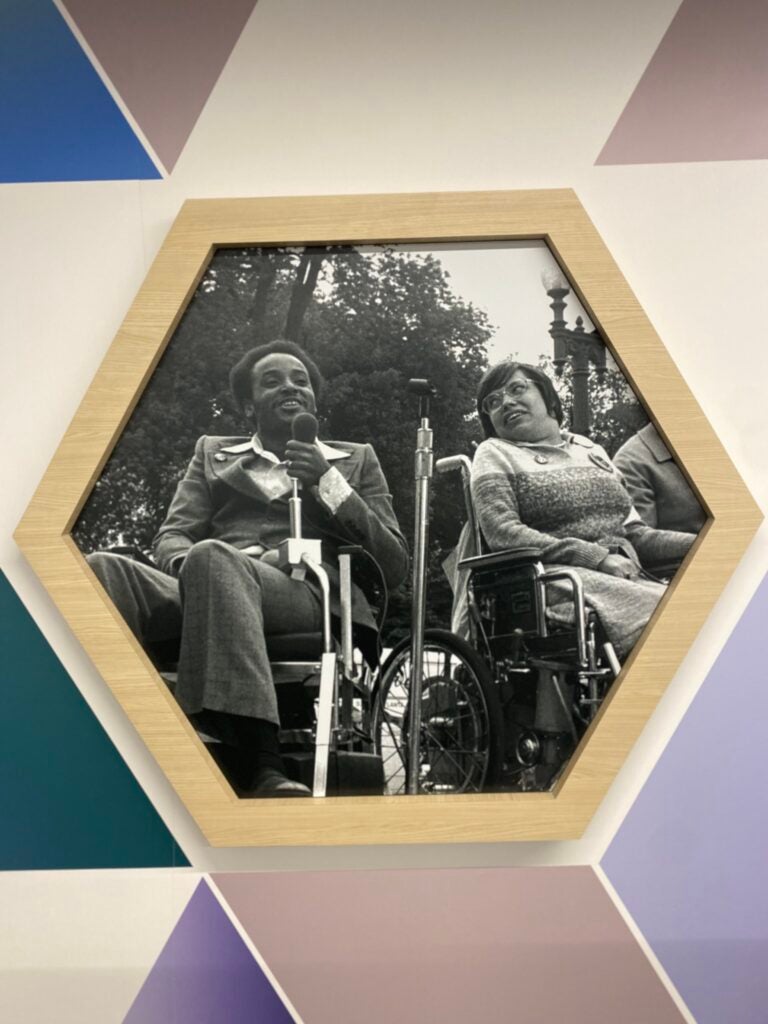
About Brad Lomax and Judy Heumann
Brad Lomax (1950-1984) and Judy Heumann (1947-2023) were key figures in the disability rights movement who helped organize the 504 Sit-in in 1977, the longest peaceful occupation of a federal building in national history, and an important moment in the disability rights movement.
The demonstration gathered over 100 people to occupy the Department of Health, Education, and Welfare (HEW) in the San Francisco Federal Building, in hopes of enforcing Section 504 of the Rehabilitation Act of 1973. Modeled on the Civil Rights Act of 1964, Section 504 prohibits disability-based discrimination in education, employment, housing, transportation, access to public buildings, and access to equal medical care, and was a precursor to the Americans with Disabilities Act of 1990.
Brad Lomax organized the Black Panthers to deliver daily meals and provisions to the organizers occupying the HEW building. Pictured together at a rally at Lafayette Square in Washington, D.C. in 1977, Lomax and Heumann helped highlight the need for better accessibility for disabled people, and advocated for disability to be understood not as an issue of charity, but one of civil rights. Heumann’s legacy can be summed up by her infamous quote: “I wanna see feisty disabled people change the world.”
Resources to Learn More
Crip Camp: A Disability Revolution
Being Heumann: An Unrepentant Memoir of a Disability Rights Activist
Overlooked No More: Brad Lomax, a Bridge Between Civil Rights Movements
Image Description
A black and white photo of Brad Lomax and Judy Heumann sitting in their wheelchairs next to one another while Brad holds a microphone. The photo is in the shape of a hexagon, with other geometric shapes around them.

About Gloria Anzaldúa
Gloria Anzaldúa (1942-2004) was an American scholar who made significant contributions to queer theory, postcolonial feminism, and Latinx and Chicana studies and philosophy.
Anzaldúa grew up in the Rio Grande Valley in South Texas, on the Mexico-United States border. a location that gave rise to her work on Borderlands. In Borderlands/La Frontera: The New Mestiza (1987), Anzaldúa invites us to embrace the duality of the borderlands. Much of Anzaldúa’s life resisted the false binary of either/or thinking, instead looking to the Borderlands as a source of wisdom. Anzaldúa calls Borderlands “una herida abierta” (an open wound), recognizing that there is both pain and possibilities for transformation in living “sin fronteras” (without borders).
Anzaldúa was a queer, disabled woman, devoted to working for justice for all communities. A prolific writer and thinker, Anzaldúa notably did not earn her doctoral degree during her lifetime. Her contributions extend beyond expected career and educational paths, weaving together language, art, poetry, activism, and scholarly discourse.
“The new mestiza” captures the “new angles of vision” for more than geographical locations, including race, heritage, religion, spirituality, gender, sexuality, and language. This consciousness embraces our OSEI vision today, recognizing that either/or mentality neglects the richness of our lives and identities. By attending to the Borderlands, we see the complexity, diversity, and life from sites that are often disparaged or under-invested.
To survive the Borderlands
you must live sin fronteras
be a crossroads.
Resources to Learn More
Anzaldúa, Gloria E. Borderlands / La frontera: The New Mestiza. 1987. San Francisco: Aunt Lute Books, 2022.
Gloria Anzaldúa And The Book That Changed The Borders (1a podcast)
To Live in the Borderlands (poem)
Image Description
A black and white photo of Gloria Anzaldua, leaning against a wall and smiling. Braille and a QR code are below. The photo is in the shape of a hexagon, with other geometric shapes around them.
